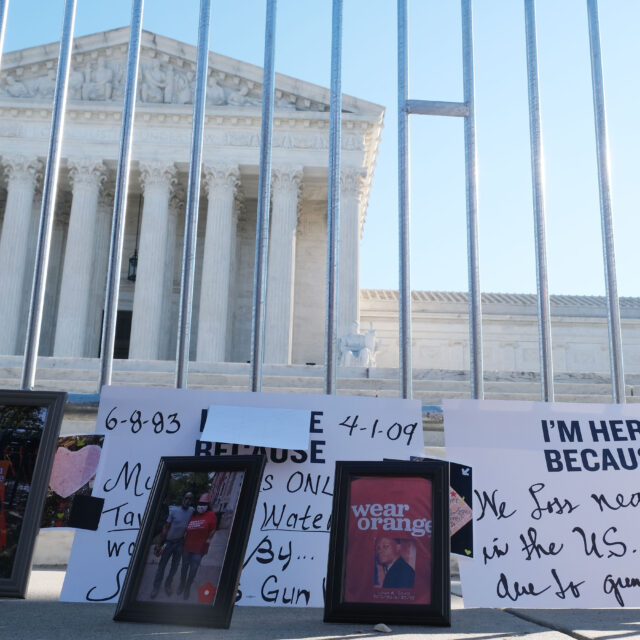Prohibiting Large-Capacity Magazines: A Constitutional Way to Save Lives

1.30.2020
On August 4th, 2019, a gunman in Dayton, Ohio used a pistol equipped to fire high-velocity rifle rounds and a 100-round large-capacity magazine to attack a crowded nightclub. Nearby police responded instantly, ending the shooting thirty-two seconds after it began. Despite the heroic efforts of police, in that 32 seconds the gunman killed nine people and shot and injured 17. Large-capacity magazines (LCMs), also known as high-capacity magazines, are the common denominator in the deadliest mass shootings. As Dayton shows, the use of LCMs in mass shootings results in large numbers of deaths and injuries regardless of how fast police or other security react. This increased lethality in mass shootings where LCMs are used has led to widespread support for LCM prohibitions.
Prohibiting the sale or possession of LCMs does not violate the Second Amendment. Every federal court of appeals that has heard a challenge to an LCM law has found it constitutional. At least one court has found LCMs aren’t protected by the Second Amendment at all because they are weapons of war. Others have found that the laws are justified because LCMs make mass shootings significantly more deadly. This article will discuss the constitutionality of LCM prohibitions in more detail.
What is it?
A prohibition on LCMs would limit the permissible size of ammunition magazines. Most state laws (and a previous federal law) define LCMs as magazines that can hold more than 10 rounds. Two states — Colorado and Vermont — set the limit at 15 rounds (Vermont limits magazines to ten rounds for long guns and 15 for handguns).
Why is it important?
The use of LCMs in mass shootings results in more shots fired, people wounded, and wounds per victim than do other gun attacks because an assailant can continuously fire without pausing to reload. Everytown’s tracking of mass shootings shows that LCMs are almost always used in the highest-fatality events. These include the shootings in Dayton, Ohio where nine were killed and 17 were injured; the attack in El Paso, Texas where 22 were killed and 24 injured; the shooting in San Bernardino, California, which resulted in 14 deaths and 22 injuries; the massacre of 49 people and wounding of 53 more in a nightclub in Orlando, Florida; the attack in Las Vegas, Nevada in which the shooter used dozens of LCMs to fire hundreds of rounds into a concert crowd resulting in the death of 58 people and the direct injury of at least 413 more; the attack on a church in Sutherland Springs, Texas that resulted in 25 deaths and 20 injuries, and; the attack on an elementary school in Newtown, Connecticut that left 27 dead and two injured. When a shooter can fire more rounds before needing to stop and reload, they inflict more wounds over the course of an attack. In mass shootings from 2009 to 2018, incidents where the shooter is known to have used a LCM resulted in twice as many fatalities and 14 times as many injuries per incident as those that did not involve an LCM. Moreover, restrictions on LCMs are associated with fewer mass shootings overall: whether or not a state has a LCM prohibition has been found to be “the single best predictor” of that state’s rate of mass shootings.
LCMs are also used in day-to-day gun crime. Overall, semi-automatic weapons equipped with LCMs account for an estimated 22–36% of crime guns, and over 40% of guns used to commit serious violence. Trends suggest that these percentages have been increasing since the federal prohibition on LCMs expired in 2004. As in mass shootings, when criminals use LCMs to commit other violent crimes, they generally fire more shots and injure more people.
Nine states and the District of Columbia have passed laws prohibiting LCMs.
Is it constitutional?
Yes. When federal courts of appeals across the country have faced questions about the constitutionality of LCM prohibitions, they have universally agreed that they do not infringe on Americans’ Second Amendment rights.
The Supreme Court has never addressed the constitutionality of LCM prohibitions — but what the Supreme Court has said about the Second Amendment indicates that restricting LCMs does not violate the Constitution. According to the justices, self-defense, especially in the home, is the “core” of Americans’ Second Amendment right. The Court however, made clear that the right protected by the Second Amendment is not unlimited. It is “not a right to keep and carry any weapon whatsoever in any manner whatsoever and for whatever purpose.” The Court said that a wide range of firearms regulations do not infringe on Americans’ right to self-defense, including reasonable restrictions on what kinds of guns may be kept and carried.
Federal courts of appeals in the First, Second, Third, Fourth, Seventh, and D.C Circuits have ruled that LCM restrictions do not infringe on the Second Amendment. These courts have also found that LCM prohibitions advance important public safety objectives. The Second Circuit found LCMs are “disproportionately used in mass shootings,’ which result in “more shots fired, persons wounded, and wounds per victim than do other gun attacks.” Several courts have emphasized that an attacker’s magazine size can make a life-or-death difference for both police officers and civilians. For example, the D.C. Circuit highlighted how the pause a shooter takes to reload can be “of critical benefit to law enforcement,” while the Third Circuit found that the “delay associated with reloading…may provide an opportunity for potential victims to escape or for a bystander to intercede.” Courts have also recognized that LCM prohibitions protect the public because LCMs make defensive shootings more dangerous: inexperienced civilians who find themselves in danger will often empty their weapon’s magazine, whatever size it is, and when people fire more rounds than necessary to stop or scare off an attacker, they run a higher risk of hitting a bystander. The D.C. Circuit found that this “tendency…to keep firing until all bullets have been expended, which poses grave risks to others in the household, passersby, and bystanders.” Since LCMs are not protected by the Second Amendment and removing them from our communities serves the government’s interest in protecting life, virtually every federal court that has been asked to overturn an LCM prohibition has instead upheld it. Just one federal district court has departed from this consensus, in a recent decision that is undermined by its many legal and factual errors.
For Congress to pass a federal law, it is not enough for that law to not violate any constitutional rights. Federal laws must also be authorized by some affirmative power that the Constitution gives to our legislative branch. The power to prohibit LCMs comes from the Commerce Clause, which allows Congress to regulate interstate commerce. Congress exercised this power over LCMs before, in the Federal Assault Weapons Ban of 1994. The law was challenged for exceeding the powers of Congress under the Commerce Clause — and this challenge was rejected by the United States Court of Appeals for the D.C. Circuit, confirming that Congress has the ability to make rules for the production, purchase, and possession of LCMs nationwide.
Research shows clearly that laws prohibiting large-capacity magazines can reduce the lethality of mass shootings. Prohibiting them would not violate the Second Amendment, and would save the lives of law enforcement officers, people targeted by active shooters, and other innocent bystanders.




